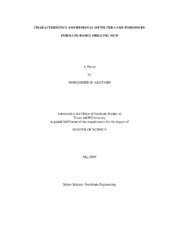| dc.description.abstract | Formate-based mud has been used to drill deep gas wells in Saudi Arabia since 2004.
This mud typically contains XC-polymer, starch, polyanionic cellulose, and a relatively
small amount of calcium carbonate particles, and is used to drill a deep sandstone
reservoir (310°F). Calcium carbonate particles are frequently used as weighting material
to maintain the pressure that is required for well control and minimize the leak-off. Such
solids become consolidated and trapped in the polymeric material and this makes the
filter cake a strong permeability barrier.
Various cleaning fluids were proposed to remove drilling mud filter cake;
including: solid-free formate brine and formate brine doped with organic acids (acetic,
formic, and citric acids), esters, and enzymes. The main objective of this research is to
assess the effectiveness of these cleaning fluids in removing drilling mud filter cake. A
dynamic high-pressure/high-temperature (HPHT) cell was used to determine
characteristics of the drilling mud filter cake. Drilling mud and completion fluids were
obtained from the field. Compatibility tests between potassium formate brine, cleaning fluids, and formation brine were performed at 300ºF and 200 psi using HPHT visual
cells. Surface tensions of various cleaning fluids were also measured at high
temperatures.
The conventional method for cleaning the filter cake is by circulating solid-free
formate brines at a high flow rate. This mechanical technique removes only the external
drilling fluid damage. Citric acid at 10 wt%, formic acid, and lactic acid were found to
be incompatible with formate brine at room temperature. However, these acids were
compatible with formate brine at temperatures greater than 122°F. Only acetic acid was
compatible with formate brine. A formula was developed that is compatible at room and
reservoir temperature. This formula was effective in removing filter cake. A corrosion
inhibitor was added to protect downhole tubulars. In general detail, this research will
discuss the development of this formula and all tests that led to its development. | en |


